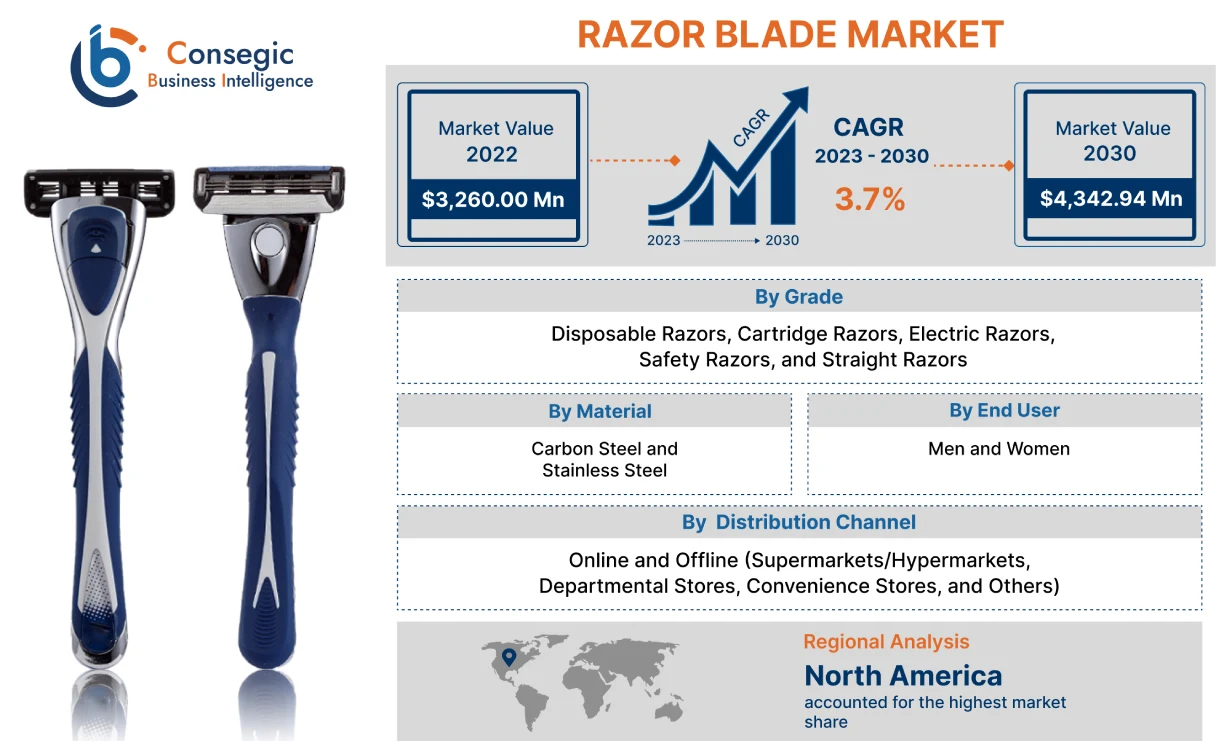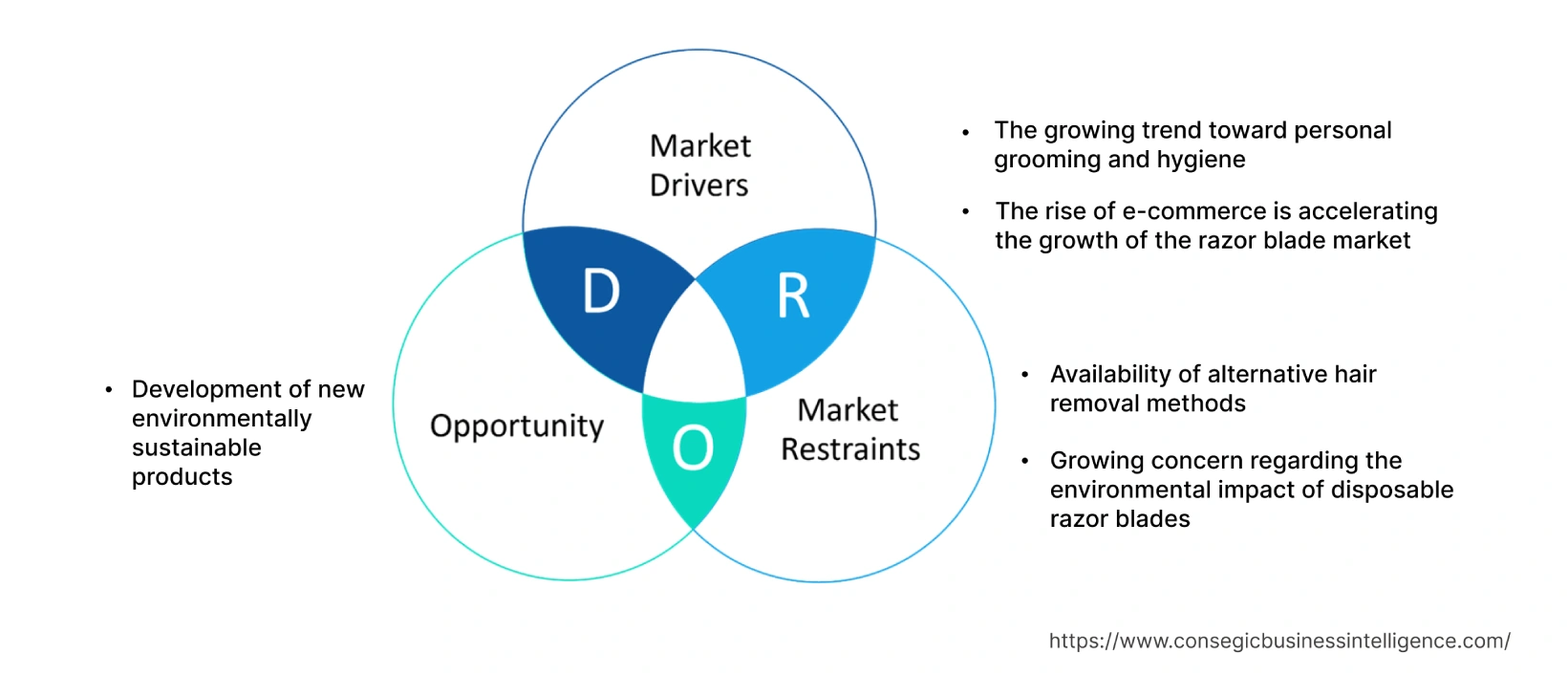- Summary
- Table Of Content
- Methodology
Razor Blade Market Size :
Consegic Business Intelligence analyzes that the razor blade market size is growing with a CAGR of 3.7% during the forecast period (2023-2030), and the market is projected to be valued at USD 4,342.94 Million by 2030 from USD 3,260.00 million in 2022.
Razor Blade Market Scope & Overview:
Razor blades is a thin, flat, piece of metal that is used to shave hair from the face, legs, and other parts of the body. Razor blades are typically composed of stainless steel or carbon steel as these materials are resistant to rust and corrosion. These blades are designed to be sharp and durable so that they could cut hair with minimal effort and ensure the elimination of irritation or injury to the skin. There are various types of razor blades commercialized in the market namely straight razors, cartridge razors, and safety razors.
Razor Blade Market Insights :
Key Drivers :
The growing trend toward personal grooming and hygiene
The rising concern among the population about their appearance and hygiene is urging people to purchase shaving products. These products include razors and razor blades to maintain a presentable appearance. The trend is particularly strong among young consumers that are more likely to prioritize personal grooming and hygiene. In addition, the rise of social media is contributing to the trend of increasing grooming among men and women. As a result, the growing trend towards personal grooming and hygiene is driving the growth of the market.
The rise of e-commerce is accelerating the growth of the razor blade market
Online retailers have made it easier for consumers to purchase razor blades from the comfort of their own homes. Thus, terminating the need to visit a physical store. This has increased the convenience of purchasing razor blades which have made the product highly accessible to consumers. In addition, e-commerce has made it efficient for consumers to compare prices and product features across different brands which are contributing to the growth of the e-commerce sector at the global level. Hence, the rise of e-commerce is serving as the driving factor for the razor blade market.
Key Restraints :
Availability of alternative hair removal methods
The presence of alternative hair removals methods such as waxing, threading, trimmer, and laser hair removal are serving as the major restraining factor in the global razor blade market. For instance, laser hair removal methods are becoming increasingly popular among consumers, particularly among youngsters that are likely to prioritize convenience and long-term results over the short-term benefits of shaving. Thus, the availability of various alternative products for razor blades is restraining the growth of the market.
Growing concern regarding the environmental impact of disposable razor blades
Disposable razors are non-biodegradable which can lead to billions of pieces of hazardous waste. For illustration, the production and disposal of razor blades contribute to plastic waste that takes hundreds of years to decompose and could harm wildlife and the ecosystem. In addition, disposable razor blades are often non-recyclable that end up in landfills or oceans causing further environmental damage. Therefore, the growing concern regarding the environmental impact of disposable razor blades is likely to hamper the growth of the market.
Future Opportunities :
Development of new environmentally sustainable products
The rising awareness for utilizing eco-friendly products is driving the need for sustainable razor blades. This growing demand is resulting in the increasing development of eco-friendly razor blades which is creating lucrative opportunities for the key players operating in the market. For instance, in February 2021, Gillette, a leading player in the razor blade market launched Planet KIND, a sustainable product range, which also included razor blades. In addition, the rising demand for razor blades that are specific to a skin type such as sensitive skin is also anticipated to offer significant opportunities to the market.
Razor Blade Market Report Insights :
| Report Attributes | Report Details |
| Study Timeline | 2017-2030 |
| Market Size in 2030 | USD 4,342.94 Million |
| CAGR (2023-2030) | 3.7% |
| By Grade | Disposable Razors, Cartridge Razors, Electric Razors, Safety Razors, and Straight Razors |
| By Material | Carbon Steel and Stainless Steel |
| By End User | Men and Women |
| By Distribution Channel | Online and Offline (Supermarkets/Hypermarkets, Departmental Stores, Convenience Stores, and Others) |
| By Region | North America, Europe, Asia-Pacific, Latin America, and Middle East & Africa |
| Key Players | BIC USA INC., SHELTON, Dorco Co, Ltd., Edgewell Personal Care, Feather Safety Razor Co. ltd., Kaili Razor, Kai Corporation., Lord International Co., Supermax, Harru's Inc., MERKUR Stahlwaren |
Razor Blade Market Segmental Analysis :
By Grade :
The Grade segment is categorized into disposable razors, cartridge razors, electric razors, safety razors, and straight razors. In 2022, the disposable razors segment accounted for the highest market share of 28.75% in the overall razor blade market. The disposable razors is equipped with various beneficial features such as ease to use, and superior efficiency carry at various places, among others. These features of disposable razors ensure superior convenience for customers, which is contributing to the growth of the market. For instance, BIC USA INC., SHELTON, headquartered in the U.S., offers disposable razors with 3 blades for a comfortable shave. In addition, the growing commercial grooming places such as spas and salons are also contributing to the growth of the market.
Moreover, the electric razors segment is expected to register the fastest CAGR in the razor blade market. The growth is attributed to the ability to provide fast and better results without any cuts and nicks. In addition, electric razors could be used repeatedly without needing to be replaced frequently as traditional razors. Therefore, the increasing adoption of electric razors owing to the advantages offered by them is expected to drive the growth of the market.
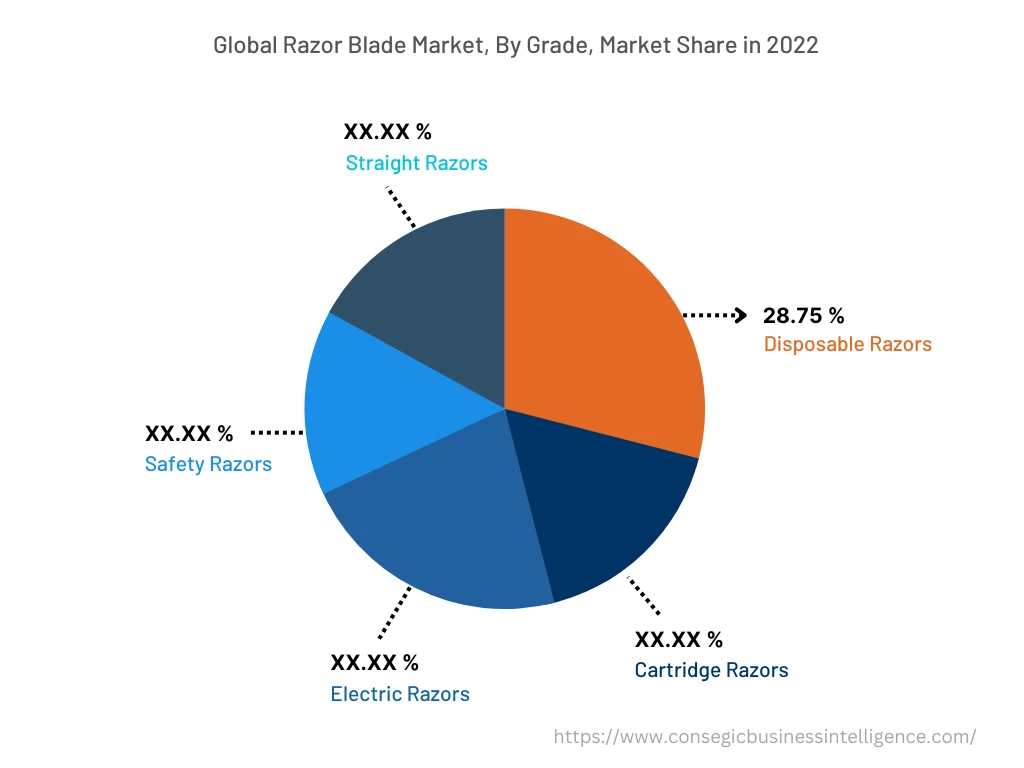
By Material :
The material segment is categorized into carbon steel and stainless steel. In 2022, stainless steel segment accounted for the highest market share in the razor blade market. The growth is attributed due to the superior characteristics offered by stainless steel, including excellent durability, and resistance against rust & corrosion, among others. For instance, Feather Safety Razor Co. Ltd. offers razor blades with stainless steel that have sharp edges and thin blades and provide easy cleaning. Furthermore, the low maintenance requirement and ability to withstand other environmental factors is also driving the growth of the segment.
Moreover, the carbon steel segment is anticipated to register the fastest CAGR over the forecast period. The widespread adoption of carbon steel, due to the properties such as edge retention and sharpness is expected to drive the growth of the market. In addition, the affordability provided by carbon steel as compared to stainless steel is anticipated to proliferate the razor blade market growth.
By End User :
The end user segment is divided into men and women. In 2022, the men segment held the highest market share in the razor blade market. The growth is attributed to the increased development of male grooming products. In addition, the key players in the market are continuously introducing new razor blades with various features including double-edge and single-edge to cater to evolving consumer preferences and to offer a variety of options. Hence, the aforementioned factors are contributing to the growth of the razor blade market.
However, the women segment is expected to register the fastest CAGR over the forecast period. This is due to the rising expenditure of women on personal care products including scented products and the increase in the number of working women which is resulting in rising awareness related to personal grooming. For instance, according to the MSP Institute eV, in 2020 women were the largest consumer group of personal care and cosmetics products. Hence, the rising demand for personal care and cosmetics products among women is expected to drive the growth of the razor blade market.
By Distribution Channel :
The distribution channel segment is divided into online and offline. In 2022, the offline segment accounted for the highest market share in the razor blade market. The offline channel is further divided into supermarkets/hypermarkets, departmental stores, convenience stores, and others. Customers exhibit a preference for physical product testing before purchasing in the offline segment. Hence, the facility of scanning the product details before purchase is the key factor driving the segment growth.
Moreover, the carbon steel segment is anticipated to register the fastest CAGR over the forecast period. The widespread adoption of carbon steel, due to the properties such as edge retention and sharpness is expected to drive the growth of the market. In addition, the affordability provided by carbon steel as compared to stainless steel is anticipated to proliferate the razor blade market growth.
By Region :
The regional segment includes North America, Europe, Asia Pacific, Middle East and Africa, and Latin America.
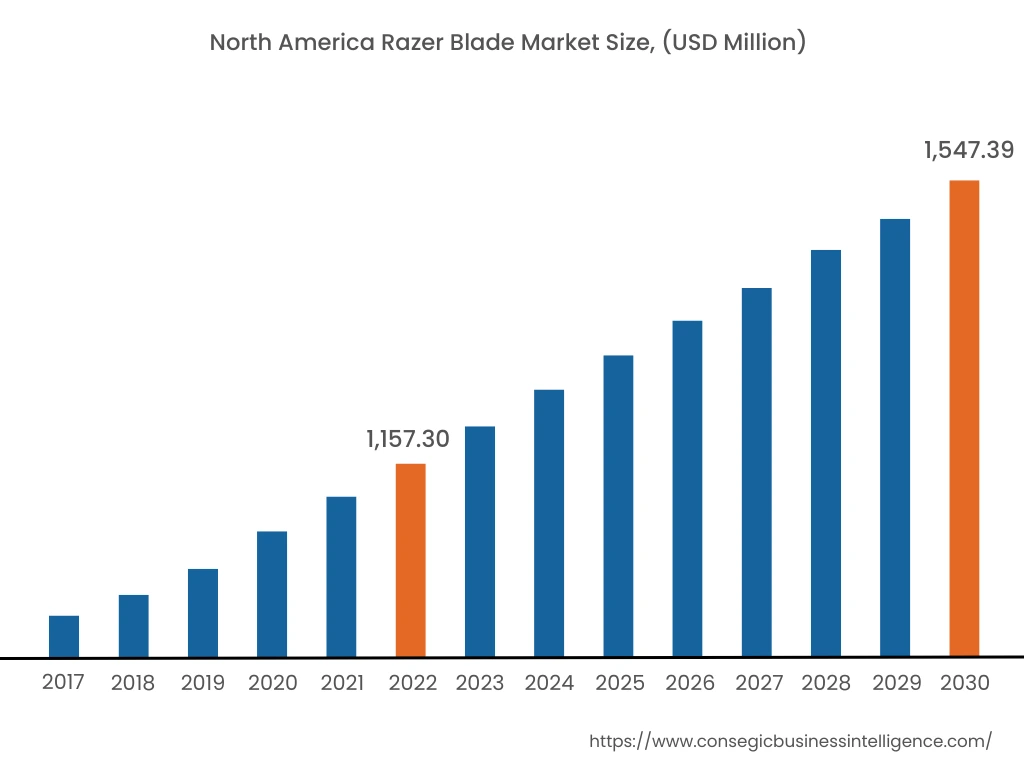
In 2022, North America accounted for the highest market share at 35.50% and was valued at USD 1,157.30 million, and is expected to reach USD 1,547.39 million in 2030. In North America, the U.S. accounted for the highest market share of 70.10% during the base year of 2022. The increasing awareness among consumers regarding personal grooming and hygiene is contributing to the growth of the razor blade market in the region. For instance, in March 2023, Billie introduced women's razor blade products in the Canadian market. The prime aim of the company was to increase its presence in the North American market. Moreover, the shifting consumer preference towards products that offer instant results including razor blades is also accelerating the market growth.
However, Asia Pacific is expected to register the fastest CAGR of 4.2% during the forecast period. The increasing number of salons and spas due to the wide adoption of personal grooming activities is anticipated to proliferate the market growth. The shifting consumer preference towards grooming and hygiene is also anticipated to surge the demand for razor blade.
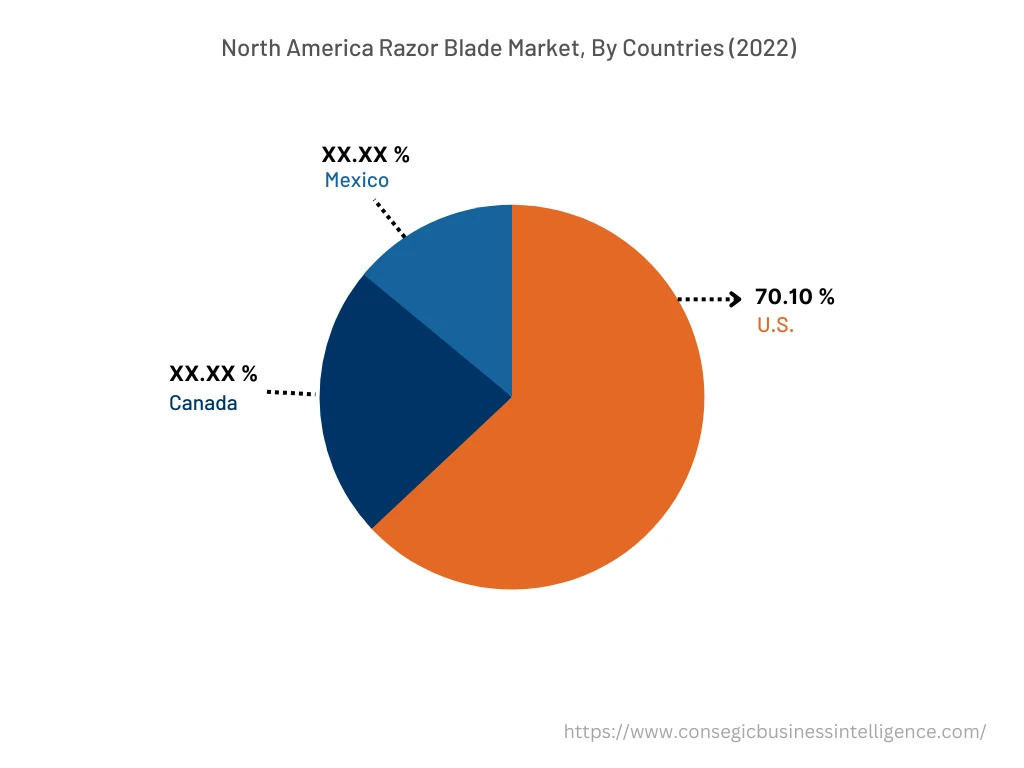
Top Key Players & Market Share Insights :
The razor blade market is highly competitive, with several large players and numerous small and medium-sized enterprises. These companies have strong research and development capabilities and a strong presence in the market through their extensive product portfolios and distribution networks. The market is characterized by intense competition, with companies focusing on expanding their product offerings and increasing their market share through mergers, acquisitions, and partnerships. The key players in the market include-
- Feather Safety Razor Co. ltd.
- Kaili Razor
- Supermax
- Harru's Inc.
- MERKUR Stahlwaren
- Kai Corporation.
- BIC USA INC.
- Dorco Co, Ltd.
- Edgewell Personal Care
- Lord International Co.
Recent Industry Developments :
- In November 2021, Edgewell Personal Care, the U.S.-based consumer manufacturer acquired Billie Inc. a company that offers women's personal care products, including razor blades.
Key Questions Answered in the Report
What was the market size of the razor blade industry in 2022? +
In 2022, the market size of razor blade was USD 3,260.00 million
What will be the potential market valuation for the razor blade industry by 2030? +
In 2030, the market size of razor blade will be expected to reach USD 4,342.94 million.
What are the key factor driving the growth of the razor blade market? +
The rising concern among the population about their appearance and hygiene is benefiting the razor blad market growth.
What is the dominating segment in the razor blade market by grade? +
In 2022, the disposable razors segment accounted for the highest market share of 28.75% in the overall razor blade market.
Based on current market trends and future predictions, which geographical region will have the fastest impact on the razor blade market's growth in the coming years? +
Asia Pacific is expected to be the fastest-growing region in the market during the forecast period.
